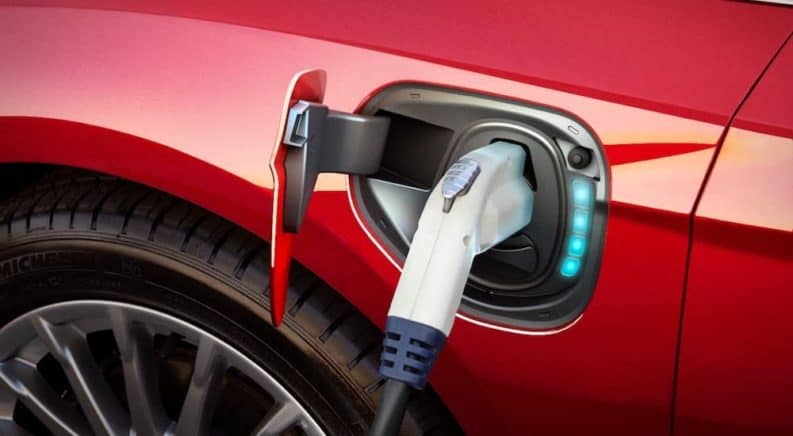No-one would (or even could) accuse Ford of being subtle, or passive-aggressive in the communication of their intentions. From day one, the pioneering giant has moved forward unapologetically, leading the charge of the automotive evolution, inspiring younger companies that would eventually rise to claim the coveted title of worthy competitors.
And it’s with this in mind that we’re still finding some humor (two years down the line) regarding Ford’s decision to name their $11.1 billion EV business unit ‘Team Edison.’ This was far more than just some casual shade being thrown at EV competitors; it was a direct call-out. This was Ford making it crystal clear that they intended to reposition themselves as a head-to-head competitor of innovative upstart, Tesla and their heralded leader Elon Musk. We’ll get to the history behind that challenge in just a few beats, but it was refreshing to see Ford take a page out of Musk’s own book and fuel a rivalry with such flair and showmanship. This was not the move of a tired or complacent automaker any more than it’s a move of desperation. This was the move of a giant awakened from a reinvigorating slumber, and thus, we’ve been keeping a close eye on Team Edison, Team Tesla and this latest installment in the “War of Currents.”
AC/DC
In the Venn diagram depicting the overlap between science, business, and popular culture, one of the most enduring (and heated) debates is whether Thomas Edison or Nikola Tesla ranks as the superior innovator.
“Splendid but utterly impractical” were the words used by Edison to describe Tesla’s ideas when the young Serbian came to work for the legendary American innovator. And of all of Tesla’s ideas, Edison’s least favorite was the utilization of alternating currents (AC) to standardize widespread electrification, which conflicted with Edison’s own strategy of lower-voltage direct currents (DC).
Both men were notorious egotists, united by science and competition, but separated by personality type and cultures. The end result would be Tesla’s prideful resignation, sparked by (what was either) Edison’s dishonorable failure to see a $50,000 ‘bet’ through, or Tesla’s inability to discern between a literal and figurative wager (the jury’s still out). But Nikola Tesla’s relative success at forming a competitive company, and sale of most his patents to Edison’s rival George Westinghouse was the nail in the coffin.
At the time of their respective deaths, Edison had boasted 1,093 patents—significantly higher than the more modest 300 patents garnered by Tesla. And while it’s easy (from a business standpoint) to declare Edison the victor based on this—and his creation of the ‘incubator’ model that allowed for wider-scale innovation, research, and development— commercial success has never been called into question more than it is today. Thus, Tesla’s penniless death and the perception that he was wronged by Edison positions him as an anti-capitalist hero in the minds of a generation plagued by democratic socialism. Factor in his quirky reputation (a stylish, socially charismatic man, albeit a hygiene-freak who feared women’s earrings) and Nikola Tesla has all the makings of a cultural billboard for millennial idiosyncrasy. So, it’s never any surprise that Elon Musk chose to recruit the iconic genius as his personal totem.
And while Ford recognizes that there’s no esteem to be garnered from Edison’s reputation as a cluttered, slovenly man uninterested style or social esteem, the historical significance of his success is not entirely indifferent from that enjoyed by Ford – an automaker who has been criticized at times for valuing function over form. In turn, Ford’s desire to reassert itself as an EV leader (in spite of Tesla’s early lead) makes the naming of ‘Team Edison’ pretty damn funny. Whether it will prove, in the long run, to be a prophetic shot calling or a tragic misstep remains to be seen.
But the world needs both Teslas and Edisons, so let’s see what Ford has in the works…
Team Edison & Beyond
It was 2017 when Ford introduced ‘Team Edison’ an 11.1 billion dollar project whose initial goal was to reinvigorate Ford’s lineup by introducing sixteen electric and over twenty hybrid vehicles by 2022.
Since hybrid and EV offerings are nothing new, some have criticized Ford for being late to the game, eager to capitalize on innovation that they had little to do with the early days of. But alternative fuel vehicles are far from being standardized hard science. There is wiggle room in terms of both innovation and execution, and most every automaker is eager to carve out their own piece of the pie with a unique approach.
According to Ford’s executive chairman, Bill Ford, “When we first started talking about electrification, there was this thought that there had to be a trade-off: it was either going to be green and no fun, or really exciting but burn a lot of fossil fuels. Electrification has come to the point that you can do both.”
Well, giving credit where is due, Tesla has been a leader in that regard — showing that practical innovation can be exciting. But no-one does mass production quite like Ford (inventing the game, allows for that sort of lofty claim) which makes the evolution of their bold objective interesting to witness. Even more intriguing is the recently announced global alliance formed between Ford and Volkswagen, introducing a whole other mindset to the brainstorming potential.
And which Ford project has captured the majority of our attention?
Go Like Hell
Based on the book by A.J. Baime there is currently a film in production detailing the 1960’s rivalry between Ford and Ferrari at LeMans. At that time, the directive given to Ford’s racing team by Henry Ford II was to “go like hell.” And it’s those three words that have been used to describe the upcoming Mustang-inspired battery-elective crossover utility vehicle that people have been buzzing about in recent months.
Originally codenamed ‘Mach 1’ the next-gen vehicle has left Ford struggling with how strong they want to imply the vehicle’s connection to its Mustang cousin. And while the enigmatic rear-facing photo teased in January did little to confirm how such a vehicle (tentatively called the Model E) will look, it is certainly fueling speculation and spirited discourse.
Consider for a moment that Tesla originally planned to name its Model 3, the Model E. Combined with the Model S and X, the lineup would spell S-E-X (with the intention of adding a Model Y down the line). But this cheeky strategy was squashed by Ford, laying claim to the Model E name, prompting Elon Musk to claim that “Ford tried to kill sex.” But setting aside what sounds more like a joke than actual events, it speaks to the high-energy nature of current competition and the recognized need to come up with something truly different. And if you’re aiming for different, Ford seems to be on the right track.
The phrase “Mustang-inspired crossover” may not roll naturally off the tongue, but if it’s any indication of Ford’s new vision, it certainly speaks to a willingness to try new things. And it’s that kind of willingness that could prove successful in reinvigorating the fatigued lineup.
In fact, Ford’s BEV (battery-electric vehicle) platform seems to be granting all kinds of freedom to create new, inspired offerings and to translate existing favorites into more sustainable versions. Consider Ford’s announcement of the battery-electric F-150, or Lincoln’s promise of a new offering to follow, stating “you can make beautiful vehicles and different ways. The BEV technology gives us so much freedom to sculpt the vehicle exactly how we want it. We’re going to create elegant Lincoln BEV’s”.
If nothing else, the thought of Ford taking things so far outside of their traditional ‘box’ is exciting—even if I’d never count myself among the automaker’s loyalist fan base. Change is good. Tesla has proven that. So I applaud Ford’s ballsy resurrection of the ‘War of the Currents’ and am looking forward to each lap of this race towards sustainability.





